Elon Musk wasted no time taking complete control of Twitter Inc. The billionaire appointed himself chief executive officer, dismissed senior management and immediately began reshaping strategy at one of the world’s most influential social media platforms as his $44 billion take-private deal closed.
Musk, 51, is replacing Parag Agrawal, who was fired along with three other top executives. The mercurial entrepreneur, who also leads Tesla Inc. and SpaceX, may eventually cede the Twitter CEO role in the longer term.
The billionaire entrepreneur, has asked managers to draw up lists of team members who could be let go.
Concerns over massive layoffs swirled in the run-up to Musk’s take-private transaction, when potential investors were told that he’d eliminate 75% of the workforce, currently near 7,500. Musk later denied that the cuts would be that deep, though he hasn’t elaborated on the job cut plans.
Musk’s acquisition puts the world’s richest man in charge of a struggling social network after six months of public and legal wrangling. Among Musk’s first moves: changing the leadership. Departures include Vijaya Gadde, the head of legal, policy and trust; Chief Financial Officer Ned Segal, who joined Twitter in 2017; and Sean Edgett, who has been general counsel at Twitter since 2012. Edgett was escorted out of the building, Bloomberg News reported.
Musk also intends to do away with permanent bans on users because he doesn’t believe in lifelong prohibitions, the person said. That means people previously booted off the platform may be allowed to return, a category that would include former president Donald Trump.
The takeover caps a convoluted saga that began in January with the billionaire’s quiet accumulation of a major stake in the company, his growing exasperation with how it’s run and an eventual merger accord that he later spent months trying to unravel. Musk’s buyout marks the end of nine years of public trading. Twitter debuted with a bang on the New York Stock Exchange in 2013 but failed to match the rocket ride achieved by some other tech heavyweights.
The change in leadership will bring immediate disruption to Twitter’s operations, in part because many of Musk’s ideas for how to change the company are at odds with how it has been run for years. He’s said he wants to ensure “free speech†on social network.
More broadly, Musk’s initiatives threaten to undo years of Twitter’s efforts to reduce bullying and abuse on the platform.
The prospect of less restrictive content moderation under Musk’s leadership has prompted concerns that dialogue on the social network will deteriorate, eroding years of efforts by the company and its “trust and safety†team to limit offensive or dangerous posts. Musk posted a note to advertisers seeking to reassure them he doesn’t want Twitter to become a “free-for-all hellscape.â€
Twitter employees have been bracing for layoffs since the transaction was announced in April, and Musk floated the idea of cost cuts to banking partners when he was initially fundraising for the deal. Some potential investors were told Musk plans to cut 75% of Twitter’s workforce, which now numbers about 7,500, and expects to double revenue within three years, a person familiar with the matter said.
The past six months have been challenging for Twitter employees, who have primarily followed the ups and downs of the roller-coaster deal through the news headlines.
Many have been unhappy with Musk’s involvement and some have questioned his qualifications to run a social networking company.
During a video Q&A with Musk in June, some employees mocked Musk on internal Slack channels. Others have ridiculed or chided him publicly on Twitter throughout the deal process.
—Bloomberg
 The Gulf Time Newspaper One of the finest business newspapers in the UAE brought to you by our professional writers and editors.
The Gulf Time Newspaper One of the finest business newspapers in the UAE brought to you by our professional writers and editors.
